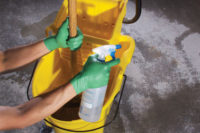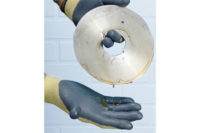
Food industry workers face a myriad of hazards, including sharp knives, extreme temperatures and harsh chemicals as well as the bacteria, grease and oils inherent in food products. Combined, these make proper glove usage essential to worker safety.
Keep the food clean
Each year 76 million people in the U.S. experience food poisoning — and up to 5,000 people die from it. Anyone who has ever suffered through food poisoning knows the importance of contamination-free food sources. Similarly, food industry workers who have endured cuts, skin irritation and other reactions while handling food are familiar with the need to protect their hands from work hazards.
In 2007, rates of work-related injury or illness for full-time food manufacturing workers were higher than the rates for all of manufacturing and for the private sector as a whole. Rates were lower than the manufacturing average for workers in bakery manufacturing, and rates were higher in seafood product preparation and packaging as well as in dairy manufacturing. On a positive note, the Bureau of Labor Statistics (BLS) data indicate that the incidence of injuries and illnesses reported in the meat industry for 2008 (the most recent year for which data are available) are the lowest (7.5 injuries per 100 full-time workers per year) since BLS began recording this data. This is an improvement of more than 70 percent over the last 17 years.
Hand in glove
Selecting the proper glove for the right application can help food handlers and food processors improve worker safety and reduce injury costs while ensuring safe food products. Wearing gloves prevents the worker’s hands from getting dirty or injured when handling food. Gloves also prevent workers, especially those with open wounds or cuts on their hands or fingers, from contaminating food.
Glove integrity is key to glove performance in food processing and food service. Gloves are charged with keeping food oils and their associated hazards off workers’ hands and, equally important, keeping potential human pathogens from workers’ hands out of food. Even though gloves have also been shown to transfer or amplify risk, the U.S. Federal Drug Administration (FDA) believes that hand washing with soap and water or even using hand sanitizers may not be enough to prevent the transmission of viral microorganisms. Various glove types have different efficacies and risk reduction limitations.
Glove regulations
Gloves used in contact with food are covered under the Title 21 of the Code of Federal Regulations (CFR). The FDA considers it necessary for all food service and food processing gloves to be covered under 21 CFR 177 parts 170-199 for repeat contact with food items under indirect food additive regulations.
The FDA food code recognizes that various grades of gloves are available for use by food facilities and considers them to be either single-use gloves or multiple-use gloves. The distinction between the two lies with material durability, strength and cleanability. Multi-use gloves are required to be durable, nonabsorbent and resistant to corrosive facility sanitizers. These gloves must also have sufficient strength to withstand repeated washing/sanitizing treatments without damage or decomposition. Both multi- and single-use glove types are required to be safe for contact with food, and rules do not permit migration of substance, color or taste to food.
Gloves for the processing environment
Because the food-processing environment is multifaceted, no one glove can be considered the industry standard. Workers preparing meat, fish and poultry need cut resistance. Food handlers working with extreme temperatures need thermal protection. Industry teams that sanitize food prep areas need barrier protection from harsh chemicals. Some workers wear the same glove over and over. Others, due to cross-contamination concerns, change gloves 30 or more times in a work shift. Some workers require ultimate dexterity while wearing gloves. For others, dexterity is not a key concern. Here is a quick look at a few of the most prevalent glove types in the food industry.
CUT-RESISTANT GLOVES: The level of cut protection needed is generally a product of the application. Applications such as cutting and deboning demand performance from advanced fiber and yarn technology materials such as Spectra and Kevlar or the use of stainless steel mesh. Advanced fibers such as Spectra are increasingly popular due the strength and cut resistance that can be incorporated into gloves through intricacies of design, knitting configurations and complexity of blended fibers. These achieve various cutresistance levels within American Society of Testing and Materials (ASTM). The ASTM uses cut protection performance as the approved test to rate performance and validates product performance and cut level.
DISPOSABLES GLOVES: Most gloves in the foodhandling environment are disposable. These range in materials from vinyl to natural rubber latex to nitrile, with various quality levels within each material category. Vinyl gloves, for example, can be of minimum quality for quick, slip-on/slip-off applications or can be highly engineered with “stretch” formulation and form-fitting comfort. Nitrile gloves tend to be of higher quality for unmatched dexterity and reduced hand fatigue required for a longer wearing period.
GLOVES FOR SANITATION: Workers faced with cleanup and sanitation responsibilities require yet another glove type — usually either a heavy-duty disposable glove or a multi-use glove that provides barrier protection to keep the sanitizing solutions away from workers’ skin. In some cases, chemical-resistant gloves are required. Multi-use gloves come lined or unlined, and some models even offer arm protection. At a minimum, they are waterproof and prevent penetration of cleaning solvents. Gloves for this purpose are available in materials ranging from nitrile and natural rubber latex to neoprene and polyvinyl chloride.
A glove for every hand
With the high rates of both food contamination and worker injury in the food industry, it is no wonder that the glove industry has put millions of research dollars into making sure there is indeed a glove for every hand involved in the U.S. food supply line.

